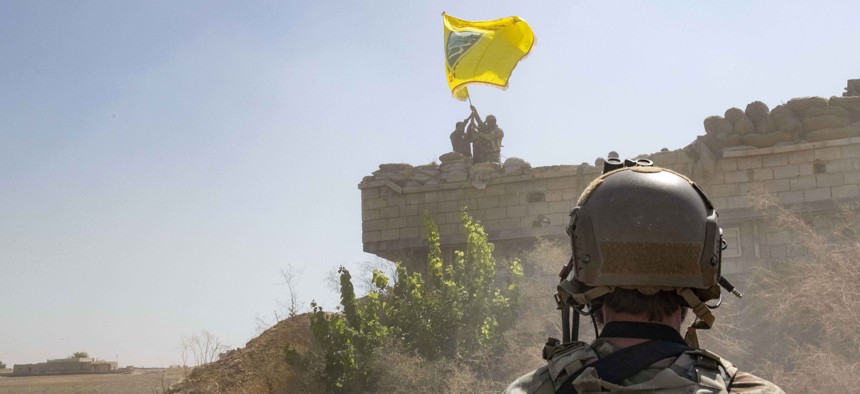
A U.S. soldier oversees members of the Syrian Democratic Forces, or SDF, demolishing a Kurdish fighters' fortification and raising a Tal Abyad Military Council flag as part of the "safe zone" near the Turkish border, Sept. 21, 2019. U.S. Army photo by Staff Sgt. Andrew Goedl via AP
'By, With, Through' Was the Best Hope for Syria — And Ending 'Endless Wars'
The U.S. acquiescence to Turkey’s invasion abandons an effective Kurdish partner, but also a creative model that was working.
Turkey’s military incursion into northern Syria carries grave implications for the United States’ Syrian Kurdish partners, the war on ISIS, and the humanitarian crisis already affecting displaced civilians in the area. Equally consequential, the Turkish attack may put an end to the U.S. military’s until-now successful “by, with, and, through” approach to the fight in Syria.
The U.S. acquiescence to Turkey’s invasion abandons not only an effective and reliable Kurdish partner, but also a creative model that could serve as a more sustainable alternative to America’s “forever wars.” This innovative approach to U.S. military operations abroad stands as a rare if limited success story in Syria.
Operating “by, with, and through” local Syrian partners, the United States and its allies in the Global Coalition to Defeat ISIS achieved a singular success in ousting ISIS from 20,000 square miles of territory in Syria. The territorial defeat of ISIS in Syria was largely accomplished via the Syrian Democratic Forces, or SDF, the United States’ local partner force which undertook much of the fighting against ISIS. Territorial victory against ISIS came at an enormous toll to the SDF, which lost more than 10,000 fighters.
At the same time, the cost in blood and treasure was relatively low to the United States and Coalition allied forces, particularly when measured against square miles of land liberated. The United States lost six soldiers in Syria over the course of combat, including four earlier this year in an ISIS-claimed suicide attack. The overall cost of the counter-ISIS war in Syria is estimated in the billions, as opposed to trillions spent in earlier wars in Iraq and Afghanistan.
Unlike previous wars in Afghanistan and Iraq, the “by, with, and through” approach pioneered in Syria (and Iraq) at the outset of the 2015 counter-ISIS military campaign relies on a small U.S. military footprint. The number of U.S. forces in Syria averaged around 2,000 at its height and more recently has hovered close to 1,000 forces. Instead, the campaign relied on the Kurdish-led SDF, a 60,000 strong local force comprised of both Kurds and Arabs.
While not without its problems, and arguably difficult to replicate its military gains so successfully anywhere else, the “by, with, and through” approach in Syria highlights the value of a locally-owned and -driven enterprise: it is organic, nimble, and responsive to circumstances on the ground. This approach is less likely to overwhelm local actors with a large foreign presence or fuel massive corruption by flooding entities with huge sums of cash. It does not aspire to large-scale nation-building as was the case in Afghanistan and Iraq. Its goals are more narrowly defined: liberate and stabilize areas once occupied by ISIS. As such, it is more sustainable and potentially more likely to develop local solutions to the drivers of conflict and the ability to manage violence in an effective, accountable, and legitimate way.
For the United States, a light footprint in foreign conflicts returns several benefits, including fewer resource requirements, less risk to U.S. forces, and a degree of burden-sharing. In Syria’s case, it has also enabled a small, expeditionary civilian component comprised of seasoned diplomats whose expertise and diplomatic skills further enhance the mission. This innovative model also accommodates the prevailing domestic sentiment in the United States which, at least for now, opposes “forever wars.”
The “by, with, and through” approach in Syria has certainly not been perfect. The U.S. decision to partner with the Syrian Kurds driven by the sole objective of defeating ISIS has arguably sowed the seeds for the current conflict with Turkey. Ankara views the Syrian Kurds as an existential threat. When he announced on Monday Turkey’s military incursion, Turkish President Erdogan vowed to “prevent the creation of a terror corridor across our southern border.” The Syrian Kurds’ ties to the Kurdistan Workers’ Party, or PKK, a U.S.-designated terrorist organization are also problematic. Turks argue they are all one in the same. While the Syrian Kurds have been praised by members of the U.S. military as among the most skilled and reliable local partner forces in recent history — and praised by some for their promotion of women in the heart of Syria — they have not been as adept at local governance, often unwilling to devolve authority to local actors, especially in Arab majority areas.
Even with these challenges, the U.S. partnership with the SDF embodied an important exemplar which with time and appropriate reforms could have provided an answer to the conundrum of America’s forever wars that Trump so eagerly wants to quit. Instead in a cruel irony, the United States may be turning its back on the very approach that holds the most hope for finally resolving the “endless war” challenge.
Emily Knowles of the Oxford Research Group contributed to this commentary.